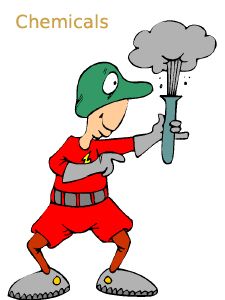Fax: (916) 381-4006



Chemicals |
 A reagent is any substance used in a chemical reaction. It usually implies a chemical that is added in order to bring about the chemical change. A reagent is any substance used in a chemical reaction. It usually implies a chemical that is added in order to bring about the chemical change.
For example hydrochloric acid is the chemical reagent that would cause calcium carbonate to release carbon dioxide. Similarly, but less obvious, hydrochloric acid is the chemical reagent that reacts with zinc to produce hydrogen even though in this case the hydrogen comes from the acid and not the metal. To classify any of the chemicals involved in a chemical reaction as the "reagent" is thus largely a matter of convention or perspective. In another use of the term, when purchasing or preparing chemicals, "reagent" describes chemical substances of sufficient purity for use in chemical analysis, chemical reactions or physical testing. Purity standards for reagents are set by organizations such as ASTM International. For instance, reagent-quality water must have very low levels of impurities like sodium and chloride ions, silica, and bacteria, as well as a very high electrical resistivity. A solvent is a liquid that dissolves a solid, liquid, or gaseous solute, resulting in a solution. The most common solvent in everyday life is water. The term organic solvent refers to most other solvents that are organic compounds and contain carbon atoms. Solvents usually have a low boiling point and evaporate easily or can be removed by distillation, thereby leaving the dissolved substance behind. Solvents should therefore not react chemically with the dissolved compounds — they have to be inert. Solvents can also be used to extract soluble compounds from a mixture, the most common example is the brewing of coffee or tea with hot water. Solvents are usually clear and colorless liquids and most of them have a characteristic odor. The concentration of a solution is the amount of compound that is dissolved in a certain volume of solvent. The solubility is the maximal amount of compound that is soluble in a certain volume of solvent at a specified temperature. Common uses for organic solvents are in dry cleaning (e.g. tetrachloroethylene), as paint thinners (e.g. toluene, turpentine), as nail polish removers and glue solvents (acetone, methyl acetate, ethyl acetate), in spot removers (e.g. hexane, petrol ether), in detergents (citrus terpenes), in perfumes (ethanol), and in chemical syntheses. Chemical indicator is any substance that gives a visible sign, usually by a colour change, of the presence or absence of a threshold concentration of a chemical species, such as an acid or an alkali in a solution. An example is the substance called methyl yellow, which imparts a yellow colour to an alkaline solution. |
| Featured Items |
|---|
| Calcium Carbonate - LB |
|
Read more »»»
$6.50 (Buy Now) |
|---|
| Hyakol 99% (Isopropyl Alc... |
|
Read more »»»
$16.00 (Buy Now) |
|---|
| Methyl Cellulose - 1oz. |
 A viscous liquid that slows the movement of protozoa for ease of observation.
Methylcellulose (or methyl ce...
A viscous liquid that slows the movement of protozoa for ease of observation.
Methylcellulose (or methyl ce... |
|
Read more »»»
$4.00 (Buy Now) |
|---|
9298 Elder Creek Road
Sacramento, CA 95829
(916) 386-2665
9298 Elder Creek Road
Sacramento, CA 95829
(916) 386-2665